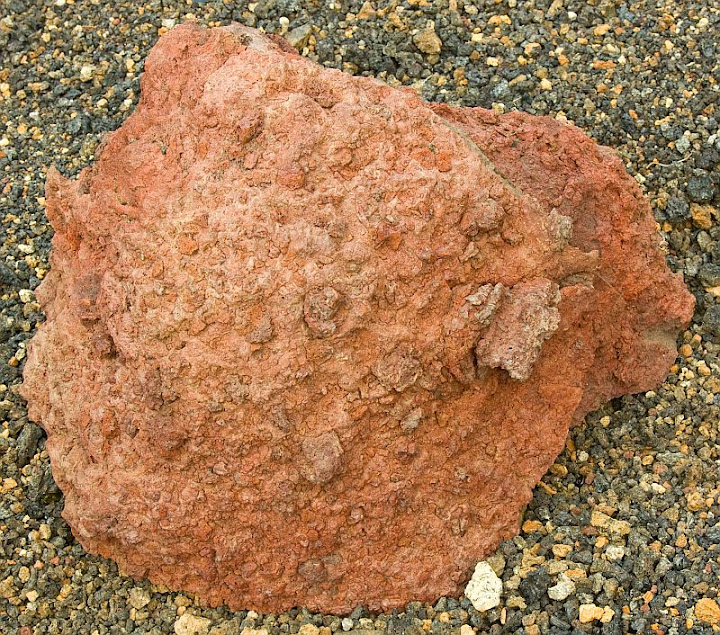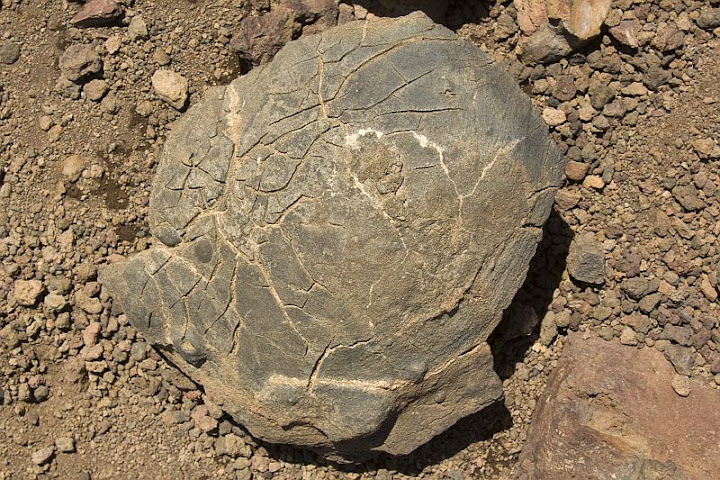Volcanic bomb is a pyroclast which was semi-molten (viscous) while ejected from a volcanic vent and is therefore shaped while in flight. Volcanic bombs are larger than 64 mm in diameter1. Smaller pyroclasts are called lapilli. Pyroclasts (>64 mm) that were already solid when ejected are called blocks. Blocks are typically more angular because unlike bombs they are not aerodynamically shaped by airflow while in flight.

An aerodynamically shaped bomb ejected from the Cumbre Vieja, La Palma, Canary Islands. Width of sample is 12 cm.
The shape of volcanic bombs varies greatly. They are usually somewhat elongated. Sometimes ribbon bombs form when long strands of lava are flung from the vent. The trailing edge of bombs is often elongated because the outermost plastic lava is pushed backwards by the rush of passing air. If the bomb spins, lemon-shaped spindle or dicus bombs form2.
Volcanic bombs are mostly produced by Strombolian and Vulcanian eruptions. These eruption types usually produce basaltic lava. Hence, volcanic bombs commonly possess a basaltic or similar mafic composition.
Volcanic bombs are heavy and often fly at high speed. It obviously makes them very hazardous to people around the active vents. However, bombs do not travel very far. The most violent Vulcanian-type eruptions have produced ejection velocities 200-400 m/s which have thrown bombs almost 5 km from the vent3. Bombs may travel even farther, but in this case they continued their journey by rolling and bouncing downwards. Each bounce rounds them by knocking off corners. At the base of the slope they are smooth lumps which are known as cannon-ball bombs.

Another bomb with a smooth vesicular surface and slightly elongated shape from the Cumbre Vieja. Width of sample is 15 cm (longer dimension).

And another one from La Palma resting on smaller lapilli. These three bombs were found close to their vents more than 2000 meters above sea level.

Smooth cannon-ball bomb on the flank of Cumbre Vieja. This bomb is far away from its vent (about 600-700 meters lower). It managed to travel so far because it is large (1.2 meters in diameter) and because the flanks of La Palma are unusually steep.

The interior of a sample from a scoria cone in Tenerife, Canary Islands. The trailing edge of the bomb is to the left. The vesicles are stretched which is a common phenomenon and a result of aerodynamic shaping. Width of view is 38 cm.

The exterior of the bomb shown in the previous picture. You can see that many smaller pyroclasts (lapilli) are attached to the bomb which demonstrates that the bomb was viscous while it landed on the ground.

Volcanic bomb from Tenerife with a vesicular scoriaceous core. Many volcanic bombs have a core which may in some cases have a different lithology. Even non-volcanic rocks are found to form cores of volcanic bombs.

Interior of a fragment of a ribbon bomb from Tenerife. Stretched vesicles are parallel to the long axis of the bomb. Width of view is 20 cm.

Exterior of the bomb shown above.

A bread-crust bomb resting near the summit of Mauna Kea, Hawai’i at an altitude of 4100 meters. This type of bomb forms when viscous, gas-rich lava is ejected from the volcanic vent. The exterior of the bomb solidifies quickly while the soft interior continues to expand because of gases that exsolve from the lump of lava. Just like in baked loaf, the internal expansion causes the brittle outer crust to crack2. Mauna Kea, Hawai’i. Width of the bomb is 26 cm.
References
1. Jackson, J. A. (1997). Glossary of Geology, 4th Edition. American Geological Institute.
2. Francis, P. & Oppenheimer, C. (2003). Volcanoes, 2nd Edition. Oxford University Press.
3. Morrissey, Meghan M. (1999). Vulcanian Eruptions. In: Encyclopedia of Volcanoes (Ed. Sigurdsson, H.). Academic Press. 463-475.
A very informative and valuable information about volcanic bomb from Strombolian and Vulcanian eruptions.